Consequences for practitioners
Practitioner have to deal with ambiguity
The word strategy holds a variety of meanings and strategy-making also comes in a vast variety of tastes.
No single definition of ‘what strategy should be’ is accepted (various people may have different perceptions or expectations). Therefore, dealing with strategy elaboration first and foremost requires building a shared interpretation of the problem to be solved.
When the problem at hand is understood, the strategist must establish as well an adequate problem solving approach and strategy development process and leadership. Indeed there is as little convergence on strategy-making that there is about ”what strategy is”.
Last but not least strategists must find ways to share and convey their findings and recommendations to the various stakeholders.
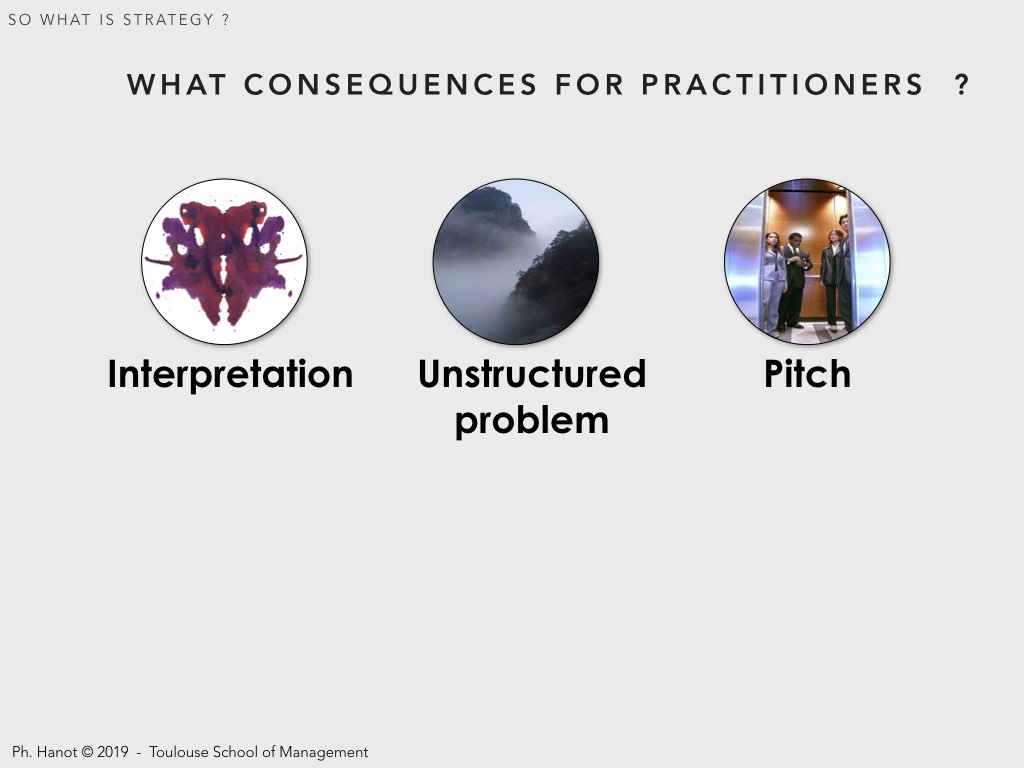
'Three main implications for practitioners'
Interpretation
Many people, from different Functions, are usually involved in crafting or updating strategies. As there is no unanimously accepted definition, different people will usually have different understandings (and possibly different expectations) of what strategy is or should be.
In most firms, strategy is not a standardized professional domain with it’s own recognized body of knowledge (there is no chartered strategist as there are chartered engineers or accountants).
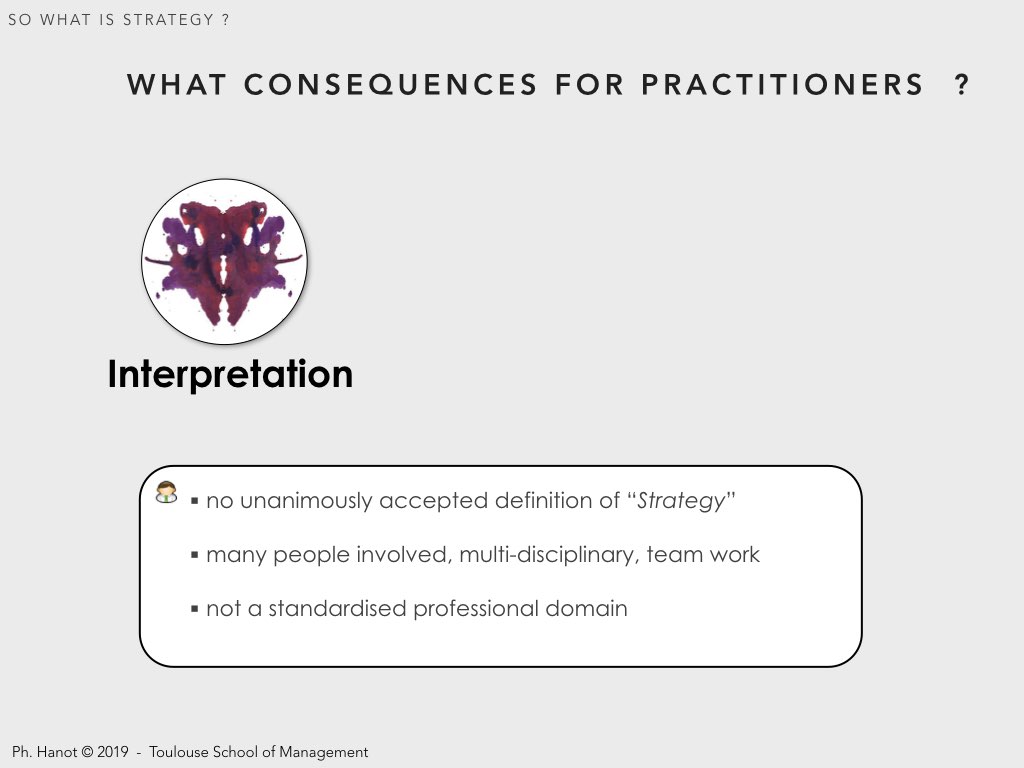
'Strategy-Making is about interpretation'
Unstructured problem
Strategy-making is in itself, a process of interpretation. It requires to deeply understand the problem statement, design an effective problem-solving method, discover candidate options and down select the optimal solution.
Although many tools exist, there is no ready-to-use recipe, no tool or framework is a silver bullet that would solve any strategic problem, and each specific case will require its own specific method.
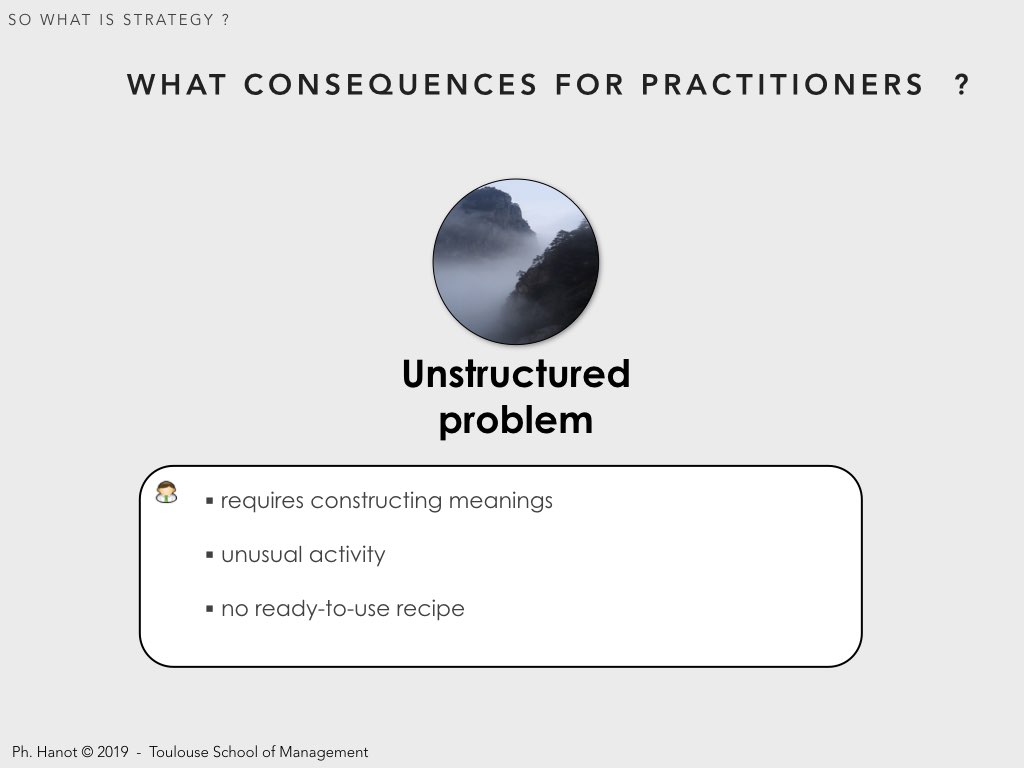
'Strategy-Making is often an unstructured-problem'
Efficient Communication
Communication skills (sometimes, negotiation skills) are paramount both for facilitating the formulation of a strategy and articulating the recommendations to the decision makers.
This usually includes an evaluation of the proposed strategy: is the option(s) suitable in terms of matching opportunities and threats ? is it feasible and does the organization control the adequate capabilities to implement the option(s) ? is it acceptable in the eyes of the main stakeholders ?
Once approved, a strategy must also get clearly communicated to all stakeholders.
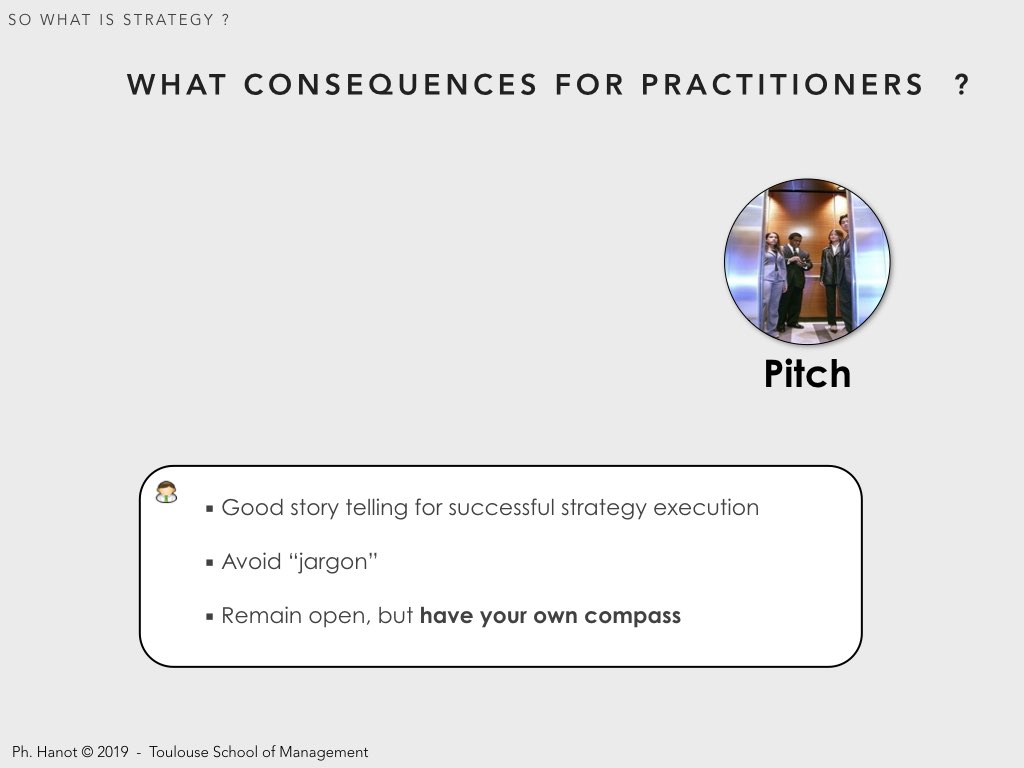
'A compelling Strategy must be easy to communicate'
Practitioners must have their own inner-compass
It is essential that practitioners have their own representation of what strategy means to them. A few models (out of many others) are briefly presented hereafter.
The VIP Model
According to Frédéric Fréry ( [Frery06] ) Strategy encompasses three major elements : value, imitation and perimeter.
On a general level, strategy comprises three objectives: creating value, handling imitation and shaping a perimeter.
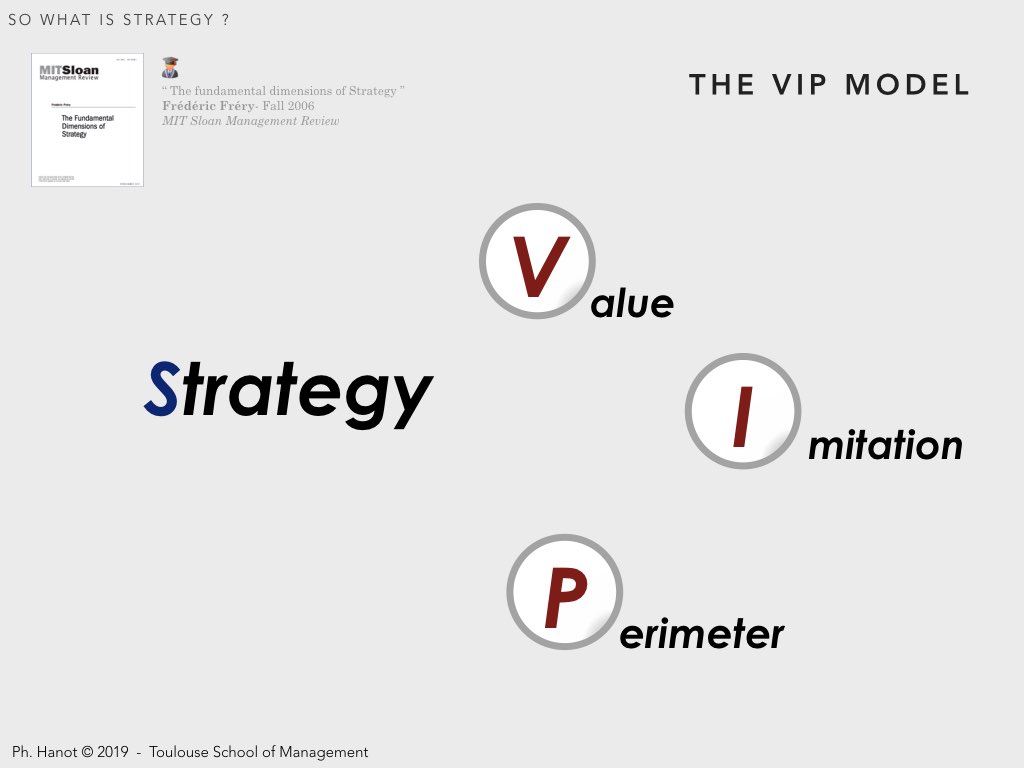
The VIP Model
Value
Strategy aims at creating sustainable value (from the perspective of customers, shareholders or more broadly any stakeholders), from which short-term and long-term over-performance can be derived.
The uniqueness of strategy resides in value creation; increasing customer value beyond cost is the seminal assumption of strategy.
Some organizations take the view that their only responsibility is the short-term interest of shareholders. However, an exclusive focus on financial results does not necessarily align managerial and shareholder interests. Some organizations are mission driven and exclusively concentrate on demonstrating best value for their customers or users. However, this stance can threaten the long-term survival of the organization and when a business reaches effectiveness at the expense of efficiency, it contradicts its basic purpose.
Defining and assessing value is therefore of the utmost importance. In addition, it is key to understand how value is shared between the firm and its ecosystem.
A sound strategy must evolve between these extremes of shareholder value and customer satisfaction, profit maximization and corporate social responsibility.
Furthermore, a firm must both create value and claim value. In other words, a firm must capture some of the value it creates.
Imitation
A firm is unlikely to continue to over-perform for long, if the recipe for its success can be easily understood and copied.
Defining a new business model and implementing an innovative value offer is worthless if competitors can quickly catch up.
Achieving and sustaining success depends on the ability to be unique and remain so. That is why imitation is a central theme in strategy, whether it consists of building and defending a sustainable competitive advantage (how to avoid imitation) or, on the contrary, matching an innovator’s positioning (how to imitate a winning business model).
Because the value of any strategic concept resides in its ability to create competitive advantage, the concept becomes irrelevant as soon as it is extensively adopted. Many best practices (ISO standards, Six Sigma, CRM) although once distinctive, have now been widely adopted.
Because it makes sense for competitors to mimic successful strategies, there is a great deal of similarity between organizations in many industries. Adopting new perspectives on business allow defining fresh strategic spaces by contrast to conventional business models.
When firms cannot find ways of differentiation (doing different things or doing the same things differently) they run the risk of strategic convergence and industry commoditization (standardized product and offers, low margins if any).
Perimeter Strategy is also deciding what to do and even more importantly what not to do (Most of the perimeter aspects are part of Corporate Strategy).
Beyond designing a valuable business model and managing imitation, shaping the perimeter of the organization (i.e. defining or setting the limits of its scope) is the overarching mission of strategists.
Decisions about diversification, outsourcing, vertical integration, internationalization and positioning, as well as defining new markets untainted by competition, are all linked with the search for a profitable perimeter.
Of course, strategy is not limited to choices related to the organizational scope, but conversely any alteration of the perimeter can be considered as a strategic move.
The DERE Model
R. Grant ( [Grant06] ) underlines that a sound Strategy must “encompass consistency of direction, based upon a clear understanding of the game being played, a keen awareness of how to maneuver into a position of advantage and an effectively & faultless implementation”.
This would remain true for strategies that don’t exist as a plan, or even are not explicitly built.
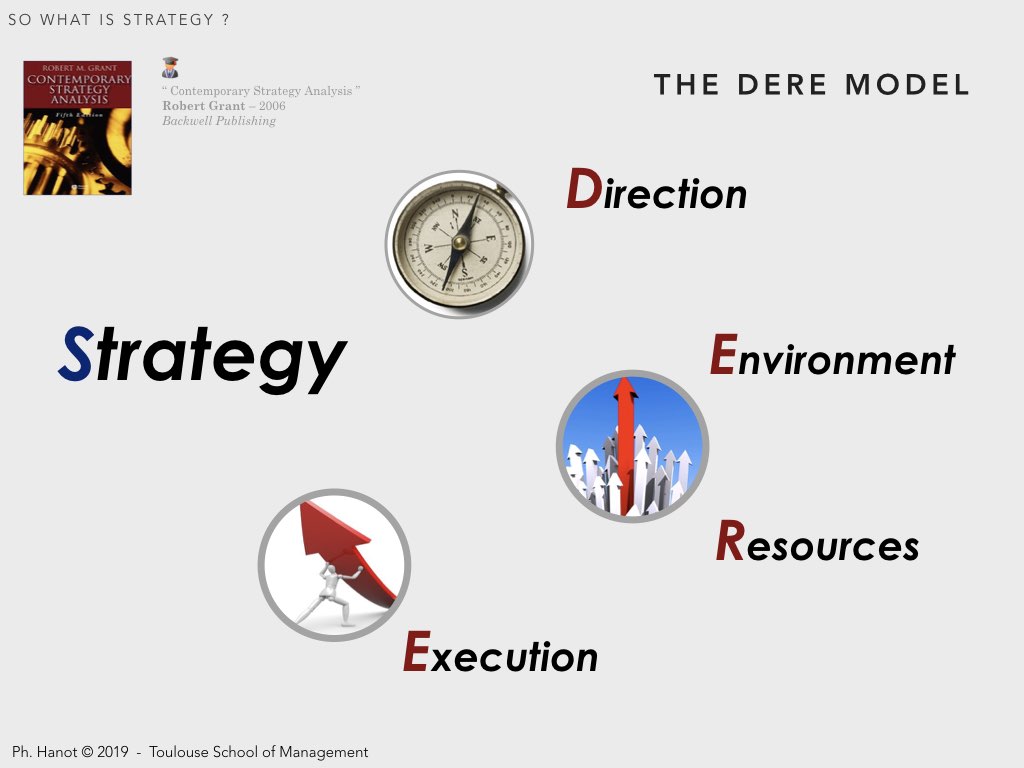
The DERE Model
Direction
Strategy must be guided by a simple, consistent a long term, single-minded commitment to a clearly recognized goal that is pursued steadfastly over a substantial period of time.
Johnson, Whittington & Scholes ( [Johnson11] ) insist that strategy is the long-term direction of a firm. „Strategy is the long term direction of an organization. […] The long term direction of Disney is from “Carton ” to diversified entertainment ”. As such it should include deliberate and logical strategy-making elements although it can also encompass more incremental and/or emergent patterns.
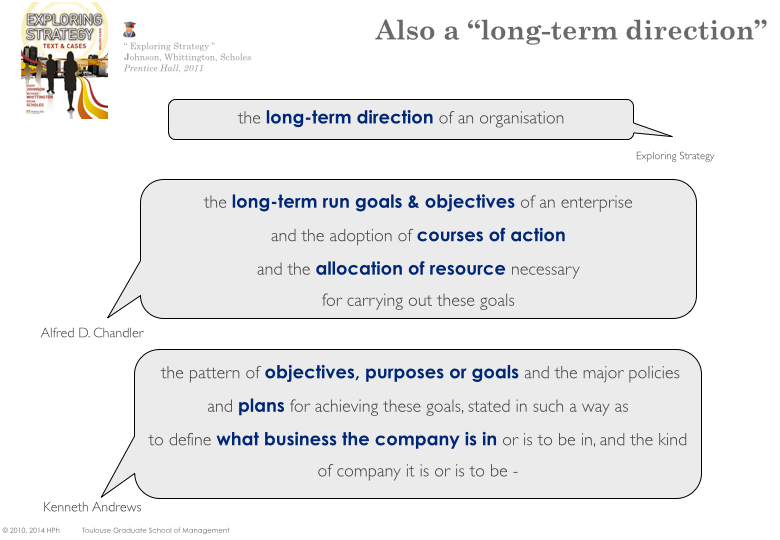
Strategy is about long-term direction
To A. Chandler or K. Andrews, two management and corporate strategy gurus, action plans do matter but only as a means of fulfilling long-term objectives, direction or goals. Strategy setting is therefore also about defining the purpose and/or (present or future) business of a company. It flows from the determination of goals to the allocation of resources.
To M. Porter, strategy is about positioning: making the deliberate choice of being and behaving differently.
Environment & Resources
Formulating a successful strategy requires more than direction. Defining a compelling strategy stems from a profound understanding of the competitive environment (“a deep and insightful appreciation of the arena in which the organization is competing ”) and a non-complacent appraisal of one’s own resource (“exploiting internal strength, while protecting areas of weakness”).
Execution
Without effective implementation (or strategy execution) the best-laid strategies are of little use.
The effectiveness of leaders in reaching decisions is key to success, as well as, their energy in implementing them, their effectiveness in instilling loyalty & commitment among subordinates and allow effective marshaling of resources & capabilities and to build organizations that promptly respond to changes in the competitive environment.